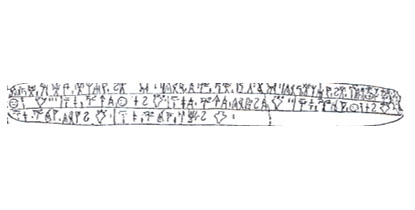THE INSCRIPTION OF PYLOS
(ORDER FORM)
An order form to a potter.
This is the way I want my pots to be.
This inscription was found in Pylos, Messinia, Greece, by Carl Blegen, during the excavations of 1952.
It dates back to 1500 B.C..

In the text we can find an order form for the construction of pots. It is a document of the technological level of that time.
We studied the phonetic values in the actual text. We understood it, we read and rendered it into Modern Greek, but we also approached it philosophically.
Identification of the phonetic values of the text.
TI RI PO DE-A I KE U-KE RE-SI JO-FE KE (2)
TI RI PO-E ME-ΠΟ DE-O FO FE (1)
TI RI PO-KE RE-SI JO-FE KE-A PY-KE KA U ME NO-KE RE A- GE TO (3)
DI PA-ME ZO E-GE TO RO FE (1)
DI PA E-ME ZO E-TI RI O FE E (2)
DI PA-ME FI JO-GE TO RO FE (1)
DI PA-ME FI JO-TI RI JO FE (1)
DI PA-ME FI JO-A NO FE (1)
Rendition of the text:
In our own view, the phonetic values are formed as follows:
TIRIPODE AIKEU KERE SIJO FEKE (2)
TIRIPO EME ΠΟDE OFOFE (1)
TIRIPO KERE SIJO FEKE APY KEKAUMENO KEREA GETO (3)
DIPA MEZOE GETOROFE (1)
DIPAE MEZOE TIRIOFEE (2)
DIPA MEFIJO GETOROFE (1)
DIPA MEFIJO TIRIJOFE (1)
DIPA MEFIJO ANOFE (1)
The language of the text is Greek, Archaic, and it resembles a Minoan text. The grammatical structure of the text is mixed.
One can identify Pontic words, as well as Classical Greek Language.
The utterance of the pronouns, the nouns and of the verbal types, follows the grammatical rules of the Pontic Dialect, as well as those of the Classical Greek Language.
Rendition of the text through the Pontic Dialect as it is used nowadays, as well as through the Classical Greek Language.
Τριπόδε άεικα κερέ σύγιο βέτρε. (2)
Τριπόδ εμεύω πόδε ωβοβένε. (1)
Τριπόδ κερέ σύγιο βέτρε απύθμενον κεκαυμένον κερειά γείτο. (3)
Δίπαν μέζονα γητούρεβε. (1)
Δίπανε μέζονε τριωβένε. (2)
Δίπαν μαβήγιον (χρωματισμένο) γητούρεβε. (1)
Δίπαν μαβήγιον (χρωματισμένο) τρύγιουβεν. (1)
Δίπαν μαβήγιον (χρωματισμένο) άνωβε(1)
The Τext in Modern Greek:
I want tripods the size of an urn .(2)
I want tripods with oval-shaped legs. (1)
I want tripods the size of an urn, with no roasted base like that. (3)
Make big cookware (1).
Big pots with three holds. (2)
Make blue cookware. (1)
Make blue cookware for dried fruit (raisins). (1)
Make blue cookware with no holds. (1)
(Τρίποδες τέτοιους στα μέτρα κάδου υδρίας.(2)
Τρίποδα επιθυμώ με πόδια αυγόσχημα. (1)
Τρίποδα στα μέτρα κάδου υδρίας χωρίς βάση στο καμίνι ψημένο ανάλογο με αυτό. (3)
Δαίπαν(οικιακόσκεύος)μεγάλοκατασκεύασε(1)
Δαίπας μεγάλους με τρεις λαβές (αυτιά) (2)
Δαίπαν χρωματοβαμμένο μπλέ κατασκεύασε. (1)
Δαίπαν χρωματοβαμμένο μπλέ για ξηρά φρούτα (σταφίδες). (1)
Δαίπαν χρωματοβαμμένο μπλέ χωρίς λαβές (αυτιά), χωρίς χερούλια. (1))
A Philosophical Approach:
According to our own approach of the text on the inscription, this is an order form of today to a workshop of the time, where ceramic and metal pots were being made.
The person in question describes in detail what he wants, by giving designs and shapes for each construction.
In order to render the meaning of the text exactly, we present a grammatical rule of the Pontic Dialect. According to the Pontic Dialect, in the Plural Form, the masculine and feminine nouns and adjectives, sometimes are neutral in gender, e.g.. o lykon-talykoude or ta lykoydia, I kossara-ta kossare or ta kossaras, o tripodas-ta tripode or ta tripodia, o mezon or mezonas-ta mezone, o pous-ta pode (ο λύκον–ταλυκούδε ή τα λυκούδια, η κοσσάρα–τα κοσσάρε ή τα κοσσάρας, ο τρίποδας–τα τριπόδε ή τα τριπόδια,ο μέζων ή μέζονας–τα μέζονε, ο πούς–τα πόδε).
It looks like a usual Pontic text with no challenges. The conclusion we can draw from the text is that this kind of neutralized Plural is very old.
This grammatical rule, known as a grammatical irregularity of the Pontic Dialect, is used since the Ancient Times. The text in question demonstrates this fact. There is no use of the dual form (δυικός αριθμός), in any case.
Τhis text is an order form for a making, by which the person who orders thoroughly describes what he wants to be constructed.
This person describes the size, the colour and the quantity, apart from the design. At a certain point we can see numbers, which stand for the quantity, 1 (one), 2(two), 3 (three).
The maker is neither a simple potter nor a blacksmith. He knows how to use the permanent dye. The person who orders asks a cup with holds, blue-coloured , like the sky.
He orders a chic blue-coloured fruit bowl for dried fruit.
The needs for utensils are the same across time. These tools are necessary for the everyday life, for storing, as well as for festivals and symposia, that is why they should be decorated and elegantly dyed.
